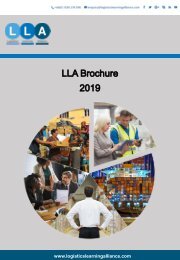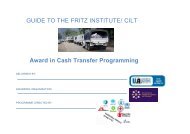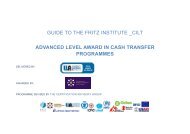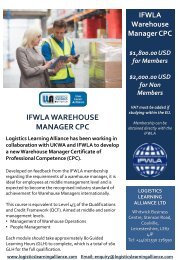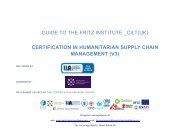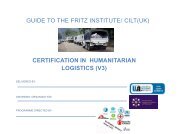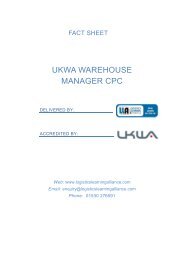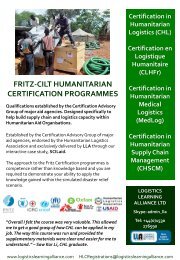CHSCM 3.0 - Unit 1 - SCM in the Humanitarian World
Learning Materials for Unit 1 of the Certification in Humanitarian Supply Chain Management (CHSCM).
Learning Materials for Unit 1 of the Certification in Humanitarian Supply Chain Management (CHSCM).
You also want an ePaper? Increase the reach of your titles
YUMPU automatically turns print PDFs into web optimized ePapers that Google loves.
Once all of <strong>the</strong> components of each supply cha<strong>in</strong> option are assessed and analyzed, you will be able<br />
to generate options for <strong>the</strong> design of <strong>the</strong> supply cha<strong>in</strong>. It is important to recognize that <strong>in</strong> most<br />
situations <strong>the</strong>re will be more than one option for <strong>the</strong> supply cha<strong>in</strong> design. Consequently, each<br />
option must be evaluated so that <strong>the</strong> most appropriate choice can be made for implementation.<br />
We will first exam<strong>in</strong>e some criteria that can be used for evaluation, and <strong>the</strong>n we will exam<strong>in</strong>e how<br />
our plann<strong>in</strong>g process can be used to amend or adjust <strong>the</strong> plan as a result of <strong>the</strong> evaluation.<br />
It is possible to use many different criteria for evaluation, but <strong>the</strong> one we will use covers three<br />
factors:<br />
• Suitability • Acceptability • Feasibility<br />
Suitability considers whe<strong>the</strong>r a plan fits with <strong>the</strong> future trends and changes <strong>in</strong> <strong>the</strong> environment, and<br />
how <strong>the</strong> plan might stretch and exploit <strong>the</strong> core competences of <strong>the</strong> organization. Suitability can be<br />
thought of as <strong>the</strong> plan’s rationale as to whe<strong>the</strong>r it makes sense <strong>in</strong> relation to <strong>the</strong> position of <strong>the</strong><br />
organization.<br />
Earlier <strong>in</strong> this unit, we exam<strong>in</strong>ed assessment and policies, standards, and strategy, not only to<br />
understand current situations but also to explore which actions might be deemed preferable. Plans<br />
might be regarded as suitable if:<br />
• Service requirements are met with<strong>in</strong> <strong>the</strong> constra<strong>in</strong>ts present<br />
• Organization strengths are capitalized and weaknesses are avoided or m<strong>in</strong>imized<br />
• Stakeholder expectations are addressed<br />
Fundamentally, a supply cha<strong>in</strong> plan has been designed to satisfy service requirements placed on it<br />
by o<strong>the</strong>r parts of <strong>the</strong> organization. A key part of suitability analysis considers whe<strong>the</strong>r or not <strong>the</strong>se<br />
requirements will be satisfied.<br />
It is also important to understand why plans might be unsuitable. First, a plan might not address all<br />
three aspects of suitability. For example, it might respond to environmental opportunities, but not<br />
maximize <strong>the</strong> strengths of <strong>the</strong> organization or meet stakeholder expectations.<br />
While one plan might meet <strong>the</strong> suitability criteria, <strong>the</strong>re could be ano<strong>the</strong>r plan that is more suitable.<br />
In such cases, each plan must be evaluated on a relative basis us<strong>in</strong>g techniques such as rank<strong>in</strong>g,<br />
force field analysis, or decision trees.<br />
All elements of a plan must be consistent. The supply cha<strong>in</strong> structure, level of resourc<strong>in</strong>g, and<br />
methods of control must all be aligned. A supply cha<strong>in</strong> will only be successful if <strong>the</strong>se elements are




